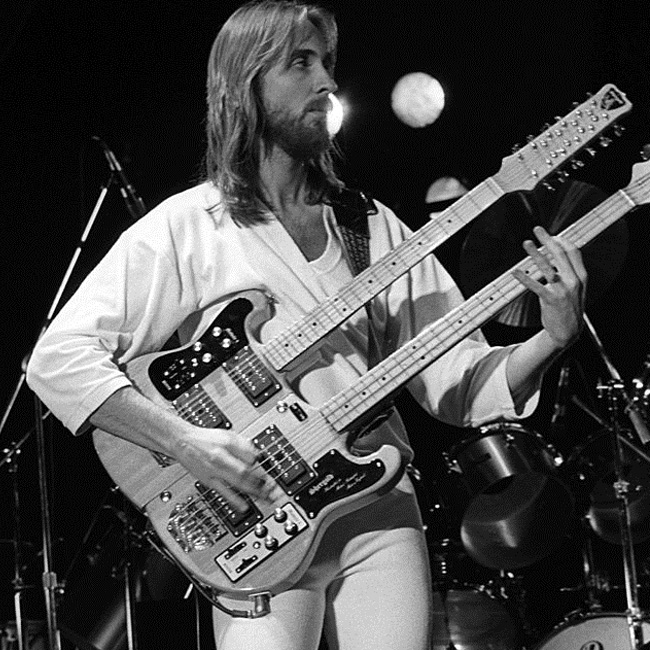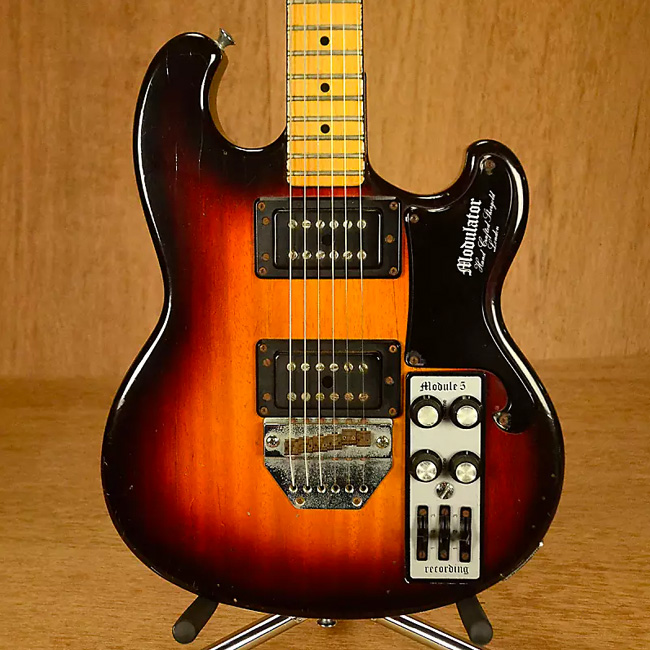Guitarists love old gear. Drummers might lust after vintage Gretsch or Slingerland kits, but no one gets more misty eyed than a guitarist when confronted with a golden-age Martin, Gibson, or Fender.
Suppose, however, you're a guitar maker who doesn't happen to own one of those illustrious brand names, yet you still want some rock 'n' roll magic attached to your products? One way is to revive a dormant brand.
Even if its name is only a hazy memory in most guitarists' imaginations, it might still have some fairy dust on its boots. Some have tried it and failed. Others have had more success. Here are a few of them. Oh, and a few more that are still candidates for Baron Frankenstein's attention, should he happen to be reading.
This is a bit cheeky, because Epiphone never actually died, although it did get pretty close back in the '50s. Founded in New York by a Greek violin maker and luthier, the Epiphone name came from Epi Stathopoulo, the founder's son and company president. By 1930, and already known as a banjo maker, Epiphone was offering its Masterbilt guitars, and it went on to rival Gibson as the top jazz guitar maker of the era with its Emperor and other archtop models.
Epi Stathopoulo died in 1943, and in 1951 a major strike saw the company attempt to move to Philadelphia. Several key figures in the business didn't want to make the journey, and they became the core of the newly formed Guild company. Epiphone never really recovered from the blow, and the company was sold in 1957 to CMI, which also owned Gibson.
Epiphone shared premises in Gibson's hometown of Kalamazoo, and its guitars from that era—acoustics as well as electrics—are much sought-after today as they were much the same as the guitars Gibson were making in the same town. Gibson may have intended Epiphone to be its lower-cost line, but the instruments were usually superb and had plenty of users in the '60s, the Beatles and the Stones among them.
By the '70s, Epiphones were being made in Japan and were no longer going head-to-head with Gibsons. Following the industry pattern, production then moved to Korea and, by the early 2000s, to China. By now Epiphone was fulfilling the role previously filled by other makers' cheap Gibson copies.
However, a few instruments were made once again in the USA in the '90s, and the brand received a major injection of cool when Epiphones were used by Oasis guitarist Noel Gallagher, with his armoury including an Epiphone Les Paul Standard, a Sheraton, and a Riviera. Gallagher wasn't alone: other well known players, including Alex Lifeson and Nancy Wilson, also played Epiphones. The guitars are primarily licensed Gibson copies, but Epiphones have somehow maintained a character and following of their own. Truly a brand that wouldn't die!
Shergold's guitars share a family likeness with the UK's Burns guitar brand, not least because they had supplied Burns with some woodwork in the '60s. Jack Golder and Norman Houlder, the two founders of Shergold, had also produced Hayman and Ned Callan guitars in the early '70s, but they enjoyed a peak from the mid-'70s to around 1980 with their own Shergold brand, producing some seriously different guitars and basses.
Highlights included a notable double neck bass, six, and 12-string guitar used by Mike Rutherford from Genesis. A bass, a six, and a 12? Yes! The necks were exchangeable! Famously light in weight—the bodies were made of obeche—a Shergold doubleneck wasn't the usual daunting prospect. Another major-name user was New Order's Peter Hook, famous for his six-string Marathon basses.


Shergold's Modulator range, meanwhile, featured interchangeable electronics modules which could be used right across the range from guitars to basses, allowing the user to completely rewire the guitar with a plug-in module. Several different options were made, including a quadrophonic version. The basic Shergold was the Meteor (£150 when new) which, while pretty basic, shared the blazingly fast neck that was a characteristic of all Shergolds.
The brand went dormant in the early '80s, although some custom models were assembled from stock parts. A brief revival followed in 1991/'92, when Masquerader guitars and Marathon basses were being sold, but the latest revival came in 2015. In that year, a major UK distributor, which had handled the original Shergolds, worked with luthier Patrick James Eggle to rethink the designs and reintroduce the Shergold name.
The comeback kid of guitar brands, Washburn's first blaze of glory was in the late 19th century when George W. Lyon (the W stood for Washburn) and Patrick J. Healy were making instruments for the U.S. music publisher Ditson. By 1880, they were making Washburn-brand instruments, which are today highly sought-after.
In 1912, it was Washburn who introduced the first dreadnought-size acoustic guitar, although they didn't actually call it a dreadnought—that was down to Martin. Lyon died in 1894, Healy in 1905, and although the business continued after their deaths, guitar making diminished in importance. In 1928, the Washburn name was sold to a distributor, and by the '40s it had ceased altogether.
Enter, over 100 years later, Rudy Schlacher, a German repairman working in the United States, who saw the potential in a revived vintage brand. He spotted that the Washburn name had been acquired and applied to a range of Japanese-made acoustics by a California company, and in partnership with Rick Johnstone he acquired the name in 1977.
With some help along the way from Roland's founder Ikutaro Kakehashi, Washburn quickly re-established itself by selling Japanese-made instruments, both acoustic and electric.
In 2009, the Washburn International company was sold to the Canadian firm Jam Industries, which itself was sold to an Irish company in September 2018. Washburns from the first incarnation—there is no connection between the two, other than an acquired name—can be very valuable, but modern Washburns have their collectors, too.
There aren't many guitar companies that can claim Elvis as a user, but the Swedish-made Hagstrom brand can. They can also claim Jimi Hendrix, as he famously used their eight-string bass on Axis: Bold As Love. Add Kurt Cobain, David Bowie, Joe Walsh, and Frank Zappa, and it's clear that Hagstrom had something going for it.
The firm was founded in Sweden in the '30s to build accordions, and Hagstrom added guitars and amps in the '50s. During the '60s, Hagstrom made cheap models sold in the U.S. as Kent (not to be confused with the other Kent brand) and in the UK as Futurama, and these provided starting-out instruments for many players. But it was the Swede and the Viking models that really did the business for the company. Hagstrom even made the world's first guitar synthesizer, the Swede Patch 2000. It was launched in 1976 and was way ahead of its time, and it failed to make an impact.
Hagstrom production ceased in 1983, when cheap imports overtook the company. The name languished until 2004, when it was revived, mostly for imports, although some models are still manufactured in Europe.
Germany's Framus brand may have a history that only stretches back to 1946, but from its inception it inherited a legacy of serious craftsmanship. It was the brainchild of Fred A. Wilfer, who wanted to provide employment for German musical instrument makers who were resettled in Bavaria after World War II. Framus quickly established itself with a reputation for quality instruments, and by the late '60s it could claim to be Europe's largest guitar maker.
On offer by Framus was everything from basses (famously used by Rolling Stone Bill Wyman in the band's early days) through archtops, steel-string acoustics, and solidbody electrics. Worthy though they were, they lacked the glamour and glitz of American instruments, and the company fell prey to Japanese imports, collapsing into bankruptcy at the end of the '70s.
The brand's rebirth came about in 1995 when Wilfer's son, Hans-Peter, revived the name. Hans-Peter had already established his own successful instrument venture, Warwick. Notable Framus users today include Earl Slick and Devin Townsend.
There are plenty of other brands that have come back from the dead—perhaps you can remind us of some of them? But here are a few that haven't and yet still could.
Once the USA's largest guitar producer, the brand appeared mostly on beginners' instruments. But some Harmony models, both electric and acoustic, have become sought-after collector's items. A Harmony Sovereign acoustic can be heard on Led Zeppelin's 'Stairway To Heaven.' In late 2017, BandLab announced plans to revive the brand and had prototypes on hand at the Winter and Summer NAMM in 2018. While the guitars were expected to be available for purchase this summer, they've yet to appear. Harmony's full return remains to be seen.
Update, 6/26/2019: They're alive. The three new Harmony models—the Silhouette, Rebel, and Jupiter—are now available for pre-order through Reverb.
Sub-Fender designs, maybe, but the UK's Watkins guitars were immensely popular in the '60s. Made by Sid and Reg Watkins, brothers of the amp and PA pioneer Charlie Watkins, the Watkins guitars were affordable when Strats were not. They have considerable nostalgia value.
At one point in the '80s, the American brand Kramer claimed to have overtaken Fender in the number of guitars it produced. Spun out of Travis Bean in the '70s, it eventually abandoned the aluminum necks it started with and became the shred guitar brand of the era, particularly when used by Eddie Van Halen. Eventually acquired by Gibson, the brand has languished in recent years—even if it isn't technically dead.
Like Kramer, this brand is not actually in possession of a death certificate. Hamer was once hugely successful with a slew of name endorsers, including Kiss, Wishbone Ash, Judas Priest, Bad Company, and Cheap Trick's Rick Nielsen. Hamer was big news in the '70s and '80s—it made fine guitars, and it was very well respected. Eventually the business was sold to Kaman (which also owned Ovation), and Hamer later fell victim to Fender, which purchased the Kaman company in 2007.
In 2013, Fender announced no more Hamers, but the name passed to KMC, ultimately owned by the Canadian firm Jam Industries (see Washburn, above), which has made some efforts to revive it. Jam, however, was recently sold to yet another company, so Hamer's future seems, once again, uncertain.
About the Author: Gary Cooper is a journalist working in the musical instrument and pro audio fields. He edits Music Instrument News (the UK MI industry trade magazine) and Acoustic Review. Gary also contributes to a number of other music magazines and websites. He lives in Sussex, England.






















